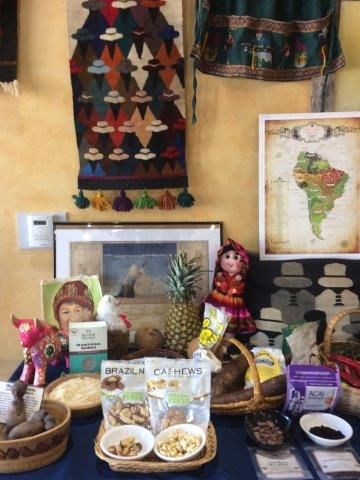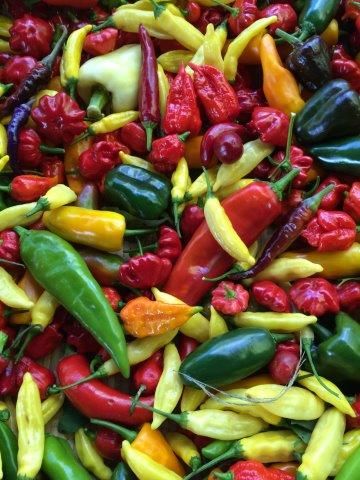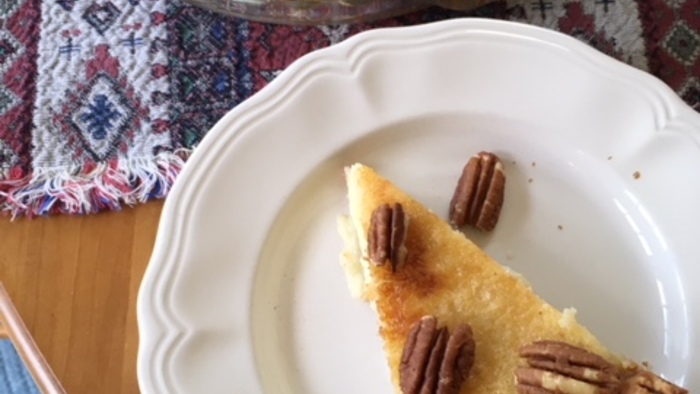
Last weekend, we celebrated the 27th annual Herb Harvest Fall Festival featuring the foods of South America, as well as chile peppers at the Ozark Folk Center. Learn about some of the foods indigenous to this continent–you might be surprised!
There are many plants that are native to south America that we eat in our everyday lives. Some of these fruits, vegetables, herbs and fruits like bananas, tomatoes, chile peppers and potatoes are familiar, while others like cinchona (source for quinine), papaloqulite (herb substitute for cilantro), and manioc root (also known as cassava and yucca) are unknown to some of us. Depending upon where we live, many of us gardeners already cultivate these food crops.
I bought a quantity of manioc roots to display and cook for one of our lunches and also the cassava flour (also sold as tapioca flour), which we made a delicious, gluten-free cheese bread from–called pao de queijo. Manioc root should never be eaten raw since it contains prussic acid (hydrocyanic acid) which can cause cyanide poisoning; cooking or pressing the root thoroughly to remove all liquid removes the poison. The poisonous liquid was used on the tips of hunting spears and arrows. Tapioca is derived from the starch of this plant and we had a chocolate tapioca for dessert that was scrumptious. I also found three colors of quinoa: black, red and white and we had a tasty quinoa salad with tomatoes and avocado garnished with toasted cashews–all ingredients indigenous to South America. Here is the link to that recipe: /item/64909/quinoa
Below is a list of foods that we researched and learned about at the Herb Harvest Fall Festival. Why don’t you cook dinner with some of these ingredients and have your own South American feast?
Some of the indigenous food crops (vegetables, herbs, fruits and nuts) of South America:
Avocado, Persea americana
Beans, Phaseolus vulgaris
Brazil Nut, Bertholletia excelsa
Cacao, Theobroma cacao
Cashew, Anacardium occidentale
Chile Pepper, Capsicum species
Cinchona, Cinchona succirubra
Coca, Erythroxylum coca
Corn (origin: Central America), Zea mays
Grain Amaranth, Amaranthus species
Lemon Verbena, Aloysia tryphylla
Manioc, Cassava, Yucca, Manihot esculenta
Papaloqulite, Porophyllum ruderale
Peanut, Arachnis hypogaea
Pineapple, Ananas comosus
Potato, Solanum tuberosum
Prickly Pear, Opuntia ficus-indica
Quinoa, Chenopodium quinoa
Stevia, Stevia rebaudiana
Sweet Potato, Ipomoea batatas
Tobacco, Nicotiana tabacum
Tomato, Solanum lycopersicum
Quinoa, Chenopodium quinoa
Vanilla, Vanilla planifolia
Yerba Mate, Ilex paraguariensis
There are numerous other South American tropical fruits, which most of us are not familiar with, that I am not including here.
Here are a few tropical fruits, as well as coffee, which are not natives, however they have been naturalized and are grown in large quantities as food crops.
Banana, Musa sapienta
Coconut, Cocos nucifera
Coffee, Coffea arabica
Lemons, Citrus limon
Limes, Citrus aurantifolia
Papaya, Carica papaya
Mango, Mangifera indica
Oranges, Citrus sinensis
Papaya, Carica papaya
Sugar Cane, Saccharum officinarum
Note: Thanks to herbalist and speaker, Kathleen Connole, for her well researched list with the botanical names of these plants.



























Comments
Log in or create an account to post a comment.
Sign up Log in